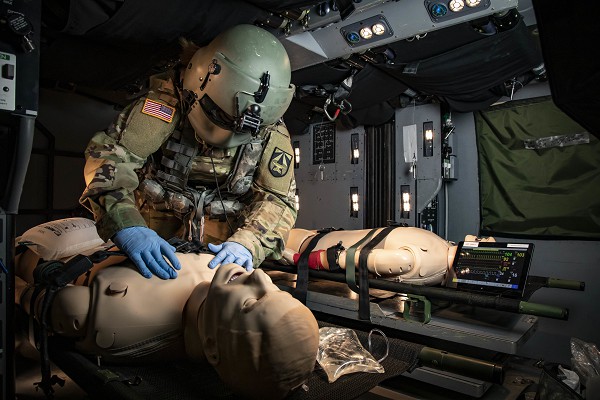 In this U.S. Army photo by Scott C. Childress, a Aeromedical Research Laboratory paramedic tests new items in a space utilization study at the Army’s School of Aviation Medicine’s DUSTOFF Training Complex, Ft. Rucker, Alabama. Here America’s military personnel train to become flight surgeons, critical care flight paramedics, and aviation nurse practitioners.
In this U.S. Army photo by Scott C. Childress, a Aeromedical Research Laboratory paramedic tests new items in a space utilization study at the Army’s School of Aviation Medicine’s DUSTOFF Training Complex, Ft. Rucker, Alabama. Here America’s military personnel train to become flight surgeons, critical care flight paramedics, and aviation nurse practitioners.
Ft. Rucker, AL. (July 27, 2022): One hour or less. That is not a guaranteed pizza delivery time, it is the time it takes for a wounded servicemember to arrive at an advanced medical facility via “Dust Off” medical evacuation.
The term “Dust Off” refers to the radio call sign given to the first aeromedical helicopter evacuation unit, the 57th Medical Detachment, in Viet Nam in 1962. This marked the birth of Medevac, the concept of using helicopters with highly trained medical crews to evacuate wounded directly from the battlefield to military surgical facilities. The goal is to dispatch, evacuate and deliver battlefield casualties within one hour no matter where the injuries occurred. This was dangerous business for pilots in Viet Nam as they were three times more likely to be shot down compared to other types of helicopter missions. Since then, highly trained air crews accompanied by medical teams achieved a 90.6 casualty survival rate in the wars in Iraq and Afghanistan.
Responsibility for training aviators and aeromedical teams falls to the School of Army Aviation Medicine at Fort Rucker, Alabama. Here military personnel train to become flight surgeons, critical care flight paramedics, and aviation nurse practitioners learning aviation medicine orientation, altitude physiology, toxicology, and how to use advanced protective equipment. The school teaches 160 unique courses and graduates upwards of 2,500 soldiers each year.
For the average warfighter, it is a comfort to know that these highly capable medical air crews will come to their rescue in an emergency.
SOT Note: Our active-duty troops, especially those deployed far from home, can also take comfort in the support they receive from patriotic Americans, like you. Please take a moment to visit our secure website https://supportourtroops.org/donate to make your tax-deductible contribution to Support Our Troops today.


